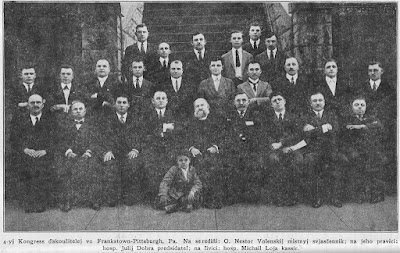 |
| Choir of St. Mary Greek Catholic Church in Wilkes-Barre, Pa., 1909. |
As I write the history of Carpatho-Rusyn communities in Pennsylvania, I will do my best to chronicle the tenures of cantors and choir directors in all of the parishes, of whichever jurisdiction. Cantors and congregational singing, whether of the Subcarpathian or Galician traditions, were part of not only Byzantine Ruthenian Catholic and Carpatho-Russian Orthodox parishes, but also Ukrainian Greek Catholic & Orthodox and even some Russian Orthodox parishes of Carpatho-Rusyn origin.
 |
| Family of Theodore Ratzin (Teodor Racyn), Wilkes-Barre, Pa., 1929. Ratzin was cantor-teacher of St. Mary Greek Catholic Church and compiled a collection of Carpatho-Rusyn liturgical plainchant (prostopinije) in 1925. (News account of his 1930 funeral online here) |
The Metropolitan Cantor Institute of the Byzantine Ruthenian Catholic Archeparchy of Pittsburgh has begun two related projects that intersect with that aspect of Rusyn American history: documenting the facts and history about parish cantors and parish choirs.
The cantor project: Remembering our professors
For many years, cantors who received comprehensive cantorial training in Europe were known in this country as “professors.” These men led church singing, taught religion classes, directed plays, and often organized church services when clergy were scarce. Over time, other particularly influential cantors were also called by the title, “Professor.”
In order to better preserve and foster our chant tradition, the Metropolitan Cantor Institute has been working with the Byzantine Catholic Seminary in Pittsburgh to collect information about these important leaders in our church. Now we are turning to you for assistance. We are particularly interested in the following cantors: [list follows at the MCI blog]
We are looking for information about where and when each of these individuals learned church music; where they served as cantors; documents, photographs or recordings, if any exist, and (most importantly) personal remembrances of their work as cantors. In the case of cantors who also composed or arranged church music, we would like to assemble either a complete or representative sample of their work.
The collected information will be used to document the history of our church singing, foster our plain chant and choral singing, and honor our cantor forebears. It will also be shared with the parishes where these cantors served.
 |
| Fr. Aleksander Duchnovič Choir of Holy Ghost Greek Catholic Church in McKees Rocks, Pa., 1921. Pastor: Fr. John Kolcun. |
The related project, Remembering our choirs:
Throughout the history of our church, there has sometimes been competition for “pride of place” between congregational singing of plain chant, and the singing of choirs (whether of harmonized chant, or of choral masterworks). The singing of our notable choirs has not only added beauty to our church in the past; it can also be used in the present to enhance and supplement our congregational singing, and show us how chant was understand or harmonized in the past. And where choirs can be re-founded or formed, they can provide opportunities to train singers in the liturgical services of our rite, and add social activities based in the parish community.
With that in mind, the Metropolitan Cantor Institute has been working with the Byzantine Catholic Seminary in Pittsburgh for some time to collect information and recordings from the principal choirs of the Byzantine Catholic Church. Now we are turning to you for assistance. We are particularly interested in the following choirs and their directors: [list follows at the MCI blog]
Our goal is assemble the following for each of our church’s choirs:
This information for each choir will be assembled, put online, and used to complete a history of our church’s musical tradition. In some cases, the MCI can provide some basic historical information from diocesan newspapers to anyone willing to write a history of a particular choir.
- Name and location(s)
- Directors and their tenure, with a biography of each if possible
- A history of the choir (beginnings, major events, and its current state or how it ended)
- Were recordings made? Detailed play list for each, and a copy if one exists (we would like to have at least a brief recording showing each choir to its best advantage)
- Photo of the choir (dated if possible)
- Choir book if one exists, or a description of the music sung by the choir (sources)
- Did the choir have a “signature” piece, and if so, what was it?
If you can contribute to either project in any way, please contact Deacon Jeffrey Mierzejewski at plainchanter@gmail.com, or by calling (412) 735-1676. Watch the MCI website and Byzantine Catholic Seminary website for updates.
 |
| Uhro-Rusyn "Solovej" Choir of Ss. Peter & Paul Greek Catholic Church, Braddock, Pa., 1911. |
 |
| Choral Society of St. Mary Greek Catholic Church, Nesquehoning, Pa., 1925. |
Original material is © by the author, Richard D. Custer; all rights reserved.



No comments:
Post a Comment
I welcome your feedback, inquiries, and suggestions. Hostile or off-topic comments will not be approved.